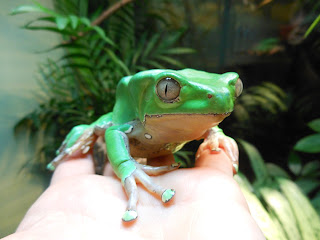Why are amphibians important?
The decline or extirpation of a species in an environment has consequences; ecological balances in food webs and nutrient cycling can become disrupted leading to dramatic long term ramifications. As amphibians are key intermediates in many freshwater systems, several effects are currently being witnessed. Because amphibians have two important life stages (generally they have aquatic larvae and aquatic or terrestrial adults), both with ecosystem value, the loss of one amphibian species is more like the loss of two distinct species.
 |
| Figure by Heidi Rockney showing repurcussions of amphibians loss according to research on amphibians and ecosystems, references listed at bottom of page |
Repercussions of larvae (tadpole) loss
The loss of amphibian larvae has an influence on the amount of local algal growth in their environments. They are key in nutrient recycling and their absence can change the amount of organic material available in aquatic freshwater systems. As amphibian larvae feed, they disturb sediments (bioturbation) that are important in the circulation of nutrients in fresh water systems. There is also evidence of increased diatom populations (microscopic algae) as a result of their absence. An increase in phytoplankton and zooplankton can affect the water quality of the entire habitat. This in turn can have dire effects on all of the animals in the ecosystem.
Repercussions of adult amphibians losses
Adult amphibian are often in the middle of the food chain and declines in amphibians have increased insect affluence and decreased abundance of predator species such as snakes. These modifications will impact trophic food webs with as of yet unknown repercussions. Their loss also leaves an open niche in the ecosystem that ultimately can pave the way for invasive species to take root. This can start a chain of extinctions of other species. Photo credit: http://extension.usu.edu/rangeplants/htm/reed-canarygrass

And if you don't like bugs, than you probably want to keep amphibians around....One small frog can eat up to 4800 bugs a year, if you have 1000 frogs that is an astonishing 48,000,000 bugs a year!!!! They also eat small rodents, spiders, worms and slugs- many creatures that humans consider to be pests. Photo credit: Life123
Medicinal benefits of amphibians
We have obtained many direct medical benefits from amphibians. Amphibians secrete mucus, toxins and proteins through their skin to stay moist and protect them from infections and predation. Examples of ailments that frog secretions have or presume to help include: heart disease, high blood pressure, antibiotic resistant infections, stomach ulcers, diabetes. Their secretions have also been shown to aid the speed of recovery in cuts and bruises and there is current research investigating how salamanders can regrow limbs and how this trait may someday help humans. In Traditional Chinese medicine, amphibians of all sorts are used to treat just about any ailment you can think of. The unique make up of the self cleaning toe pads of tree frogs, may be used to help design a new and applicable adhesive.
African clawed frogs. Photo credit: petwatch.com
Another odd thing we previously used frogs for are pregnancy tests! The African Clawed Frog will actually lay eggs if urine from a pregnant person is injected into them. They used to regularly inject these frogs with female human urine to see if she was pregnant. Luckily, we have less invasive ways of testing this now. Sadly, because people used these frogs for this, they were shipped all over the world and now may be linked to the spread of the devastating chytrid fungus that has been wiping out entire amphibian species worldwide.
And lets not forget how amphibians are representative of our ancestors that first crept out of the sea:
"The amphibians were the original custodians of the land, being the vanguard of the terrestrial (or ground-dwelling) vertebrate invasion. Next time you look at a frog in your garden, consider that its ancient ancestors explored the land 140 million years before the dinosaurs." EDGE
Below are some of my favorite amazing and charismatic amphibians:
Squeaky Namaqua Rain Frog
Japanese Giant Salamander. Photo credit: Antonio zoo
Amazonian Giant Leaf Frog. Photo credit: Heidi Rockney
Caecilians: a group of amphibians, that actually use tiny 'tentacles near their mouth as a sense organ. Photo credit: BBC
The Glass Frog, and yes those are its internal organs!. Photo credit: http://mudfooted.com/transparent-glass-frog/
 | |
| World's tiniest frog. Photo credit: Discover |
Wallace's flying frog. Photo credit: inmagine
References:
The Amphibian Ark's frog blog: medical research [online] available: http://frogmatters.wordpress.com/category/medical-research/ (2/24/2013)
Black, R. (Septemeber 18, 2005) Pregancy test link to frog fall. BBC News [online] available: http://news.bbc.co.uk/2/hi/science/nature/4257232.stm (2/24/2013)
Jacquot, J. (August 30, 2010) Frog skins could yield antiobiotic bonanza. Dsicover Magazine [online] available: http://blogs.discovermagazine.com/sciencenotfiction/2010/08/30/frog-skin-secretions-could-yield-antibiotic-bonanza/ (2/24/2013)
Department of natural resources. Michigan's frogs and toads. Michigan.gov [online] available: http://www.michigan.gov/dnr/0,4570,7-153-10370_12145_12201-35089--,00.html (3/1/2013)
Ranvestel, Anthony W., Lips, Karen R., Pringle, Catherine, Whiles, Matt R., Bixby, Rebecca J. 2004. Neotropical tadpoles influence stream benthos: evidence for the ecological consequences of decline in amphibians populations. Freshwater Biology. 49pp 274-285.
Samuel, D. (July 3, 2011) Tree frog feet go medical. Ideas, inventions and innovations [online] available: http://nanopatentsandinnovations.blogspot.com/2011/07/tree-frog-feet-go-medical.html (2/24/2013)
Schultz, D. (December 17th, 2012) Scientitists look for new drugs in skin of Russian frog. NPR [online] available: http://www.npr.org/blogs/health/2012/12/17/167255929/scientists-look-for-new-drugs-in-skin-of-russian-frog (2/24/2013)
Whiles, Matt R., Lips, Karen R., Pringle, Cathy M., Kilham SusanS., Bixby, Rebecca J., Brenes, Roberto, Connelly, Scott, Checo Colon-Gaud, jose, Hunte-Brown, Meshagea, Huryn, Alexander D., Montgomery, Chad, Peterson, Scott. 2006. The effects of amphibian population declines on the structure and function of Neotropical stream ecosystems. Front Ecol. Environ. 4(1)pp 27-34.







Congratulations on this Heidi. It's a huge accomplishment. I hope you are as proud of it as I am of you! Keep rocking it. It's important that people become aware of these kinds of issues. Actions have consequences and people really need to wake up.
ReplyDelete